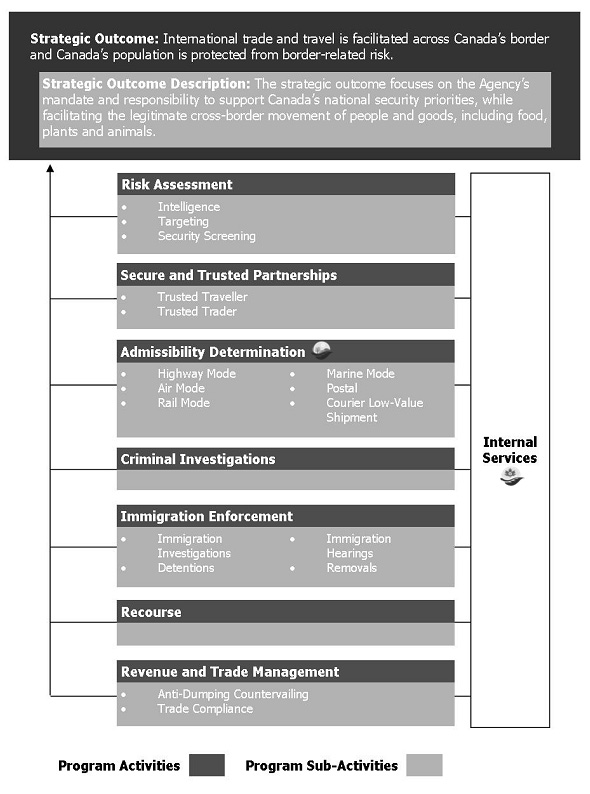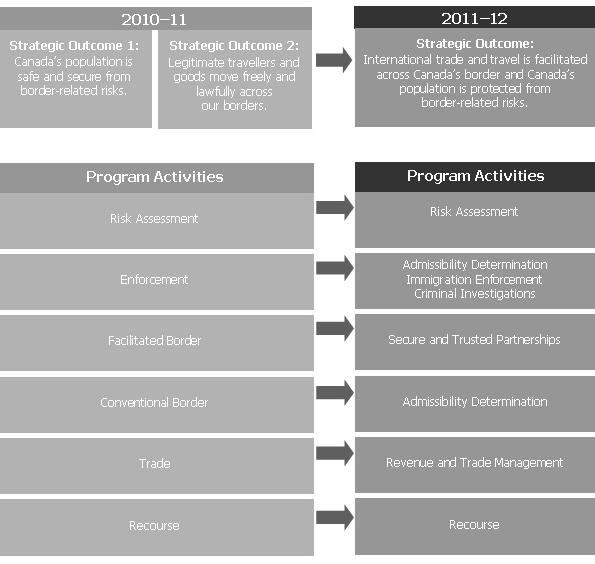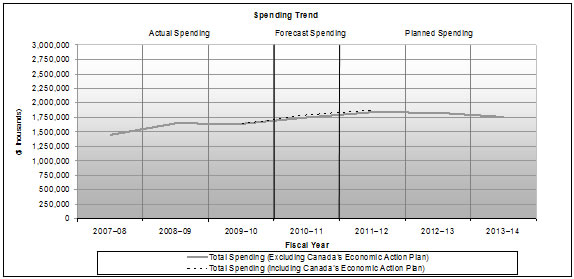Common menu bar links
Breadcrumb Trail
ARCHIVED - Canada Border Services Agency - Report
 This page has been archived.
This page has been archived.
Archived Content
Information identified as archived on the Web is for reference, research or recordkeeping purposes. It has not been altered or updated after the date of archiving. Web pages that are archived on the Web are not subject to the Government of Canada Web Standards. As per the Communications Policy of the Government of Canada, you can request alternate formats on the "Contact Us" page.
Message from the Minister
 As Minister of Public Safety, I am pleased to present to Parliament the Report on Plans and Priorities for 2011–12 of the Canada Border Services Agency (CBSA).
As Minister of Public Safety, I am pleased to present to Parliament the Report on Plans and Priorities for 2011–12 of the Canada Border Services Agency (CBSA).
The CBSA has an intricate mandate, discharged in a complex and constantly evolving environment. Today, border management processes operate at various points along a continuum, from departure overseas, to the physical border and to points inland. In this environment, the CBSA administers a broad and complementary range of services that combine to protect national security and facilitate legitimate trade and travel. In 2011–12, the CBSA will continue its commitment to vigilance and service excellence at the border.
In support of this commitment, the Agency will focus its efforts and resources on a number of critical objectives. First, it will continue to leverage its worldwide network of offices and partners to identify and interdict high-risk people and goods at the earliest possible moment, prior to arrival in Canada. Second, it will continue to implement changes to its internal management structure and processes, which will result in more efficient business delivery across the Agency. Third, it will further develop an organizational culture of service excellence in order to better recognize and respond to the expectations and needs of its clients.
In 2011–12, the CBSA will continue to demonstrate its significant value, not only as an enforcement presence at our ports of entry, but also as an outstanding public service organization for all Canadians across the country.
The Honourable Vic Toews, P.C., Q.C., M.P.
Minister of Public Safety
Section I: Departmental Overview
Raison d'être and Responsibilities
The Canada Border Services Agency (CBSA) provides integrated border services that support national security priorities and facilitate the flow of people and goods across the border, including food, plants and animals. Specific responsibilities include the following:
- administering legislation (over 90 acts) that governs the admissibility of people, goods and plants and animals into and out of Canada;
- detaining those people who are inadmissible or may pose a threat to Canada;
- identifying and removing people who are inadmissible to Canada, including those involved in terrorism, organized crime, war crimes or crimes against humanity;
- interdicting illegal goods entering or leaving the country;
- protecting food safety, plant and animal health, and Canada's resource base;
- promoting Canadian business and economic benefits by administering trade legislation and trade agreements to meet Canada's international obligations, including the enforcement of trade remedies that help protect Canadian industry from the injurious effects of dumped and subsidized imported goods;
- administering a fair and impartial redress mechanism; and
- collecting applicable duties and taxes on imported goods.
Created in 2003, the CBSA is an integral part of the Public Safety Portfolio, which is responsible for integrated national security, emergency management, law enforcement, corrections, crime prevention and border management operations.
Examples of Acts Administered by the CBSA
- Agriculture and Agri-Food Administrative Monetary Penalties Act
- Canada Border Services Agency Act
- Citizenship Act
- Criminal Code
- Customs Act
- Customs Tariff
- Excise Act
- Excise Tax Act
- Export and Import Permits Act
- Food and Drugs Act
- Health of Animals Act
- Immigration and Refugee Protection Act
- Plant Protection Act
- Special Import Measures Act
CBSA Service Locations
The CBSA provides services at approximately 1,200 service points across Canada and at some international locations, including the following:
- 120 land border crossings
- 27 rail sites
- 13 international airports
- 5 major marine port facilities
- 444 small vessel marina reporting sites
- 12 ferry terminals
- 3 postal processing plants
- 4 detention facilities
- 41 countries staffed with 57 migration integrity officers
Operating Environment
The CBSA is a unique organization, one that is both the face of Canada at the border, welcoming returning residents and visitors, and a professional enforcement agency responsible for interdicting and preventing the entry of inadmissible people and goods. Balancing these roles requires a strong commitment to service excellence that is underpinned by the Agency's values of respect, integrity and professionalism. In 2010, the CBSA adopted a new Vision Statement – An integrated border agency that is recognized for service excellence in ensuring Canada's security and prosperity – to clearly communicate to employees, partners, clients and stakeholders the Agency's commitment to service excellence.
Since its creation in 2003, the CBSA has consistently delivered on its dual mandate of managing access to the border by large numbers of people and goods, while maintaining the integrity of the border and protecting Canada from threats to its security and prosperity. The Agency has been able to do so while working in a complex environment where, to a large extent, the movement of people and goods across the border is driven by economic, political and social factors beyond its control.
A significant driver of the CBSA's workload is the state of the global and domestic economy. As economies slowly recover from the downturn, it is anticipated that the volume of travellers and shipments will increase from the over 85 million people and 11 million shipments processed in 2009–10. Furthermore, the Canadian dollar continues to be strong against the U.S. dollar, encouraging cross-border shopping and making imports more attractive to Canadian consumers and businesses. Increasing volumes will bring new security risks, greater demand for border clearance services and quicker, more predictable and cost-effective screening processes. It will become increasingly important for the Agency to ensure that the costs and delays imposed by clearance processes for legitimate, low-risk people and shipments are minimized while, at the same time, effectively identifying and interdicting diverse security threats as early as possible in the travel and trade supply chain continuum.
Partnerships
Border management is an international concern that requires global solutions and strong partnerships. Information sharing and close interaction and cooperation with domestic partners, including the Royal Canadian Mounted Police, Canadian Security Intelligence Service, Citizenship and Immigration Canada and regulatory agencies such as the Canadian Food Inspection Agency, are essential to ensuring that resources can be coordinated and directed to deal with emerging threats and the expected increase in the volume of travellers and shipments.
Within the context of the integrated North American economy, Canada and the United States both rely on rapid yet secure border clearance processes to maximize economic benefits. The CBSA works closely with its U.S. counterpart – Customs and Border Protection (CBP) – to ensure and enhance the efficient and secure cross-border movement of people and goods. The CBSA has also established working relationships with the European Union, the United Kingdom, Australia, New Zealand and Mexico, and is pursuing a partnership with Brazil in order to enter into an information-sharing and enforcement agreement. In addition, the CBSA will negotiate pre-screening and supply chain security agreements with the European Union.
Risk Management
The CBSA manages risk on a daily basis as it carries out its mandate, including the possible entry into Canada of terrorists, irregular migrants, illicit drugs, goods that could cause chemical, biological, radiological, nuclear or explosive events, counterfeit goods, firearms and inadmissible foods, plants, animals and related products. A number of domestic and global drivers influence the likelihood and impact of the risks the Agency must mitigate. Immigration continues to be a key factor in Canada's growth. Global and domestic demographic patterns suggest the possibility of increased irregular migration from high‑risk countries as well as an expected increase in the number of mass arrivals of irregular migrants (e.g. Marine Vessel Sun Sea). As the number of people and goods from non-traditional sources continues to grow, they may pose new threats and increase the risk of Canadians being exposed to acts of terrorism, transnational organized crimes, disease outbreaks and infectious diseases.
To improve competitiveness and access to world markets, Canada is negotiating trade and investment agreements with non-traditional trading partners. New trading partners often represent new compliance challenges and unknown risks as new products and substances need to be screened and controlled at the border. Increased contact with non-traditional source countries may also increase the probability of new threats reaching the border, including safety risks associated with commercial products produced in countries where the legal and regulatory system differs from that in Canada.
The CBSA relies on a risk-based approach to border management whereby the Agency focuses its efforts on people and goods that are considered high risk while facilitating the border clearance of low-risk people and goods. The Agency employs various mechanisms to help identify threats to Canada's border security, including the use of advance information to pre-screen travellers and goods before their arrival in Canada, and the sharing of intelligence to identify common border threats. The Agency's Border Risk Management Plan translates the identified threats into program delivery priorities and operational plans.
Change Agenda
Within a climate of modest economic growth and the Government of Canada's plans to return to a balanced budget and limit growth in program spending, ensuring program effectiveness and the prudent use of resources is crucial. The CBSA's Change Agenda, a multi-year transformation initiative launched in 2009–10, focuses on improving how the Agency delivers its mandate. Key achievements in the first year, including a new headquarters structure, a streamlined governance structure, the development of a Border Management Action Plan, as well as the launch of a new Agency brand and talent management program for the executive cadre, set the stage for further progress in how the Agency manages its business.
The next phase of the Change Agenda focuses on three main areas: front-line service delivery (entrenching a culture of client service excellence to better understand client expectations and needs); people management (attracting, retaining and developing the right people with the right skills to achieve the Agency's goals); and management excellence (managing the Agency's programs consistently across the organization through rigorous fiscal management and performance monitoring). These activities will bring greater focus to the support the CBSA provides to its employees and will enhance the level of service the Agency offers to Canadians.
Contribution to the Federal Sustainable Development Strategy
The Federal Sustainable Development Strategy strengthens the way in which the Government of Canada promotes environmental sustainability and makes important improvements to the transparency and accountability of environmental decision-making. The federal strategy addresses four high-priority themes: addressing climate change and air quality; maintaining water quality and availability; protecting nature; and shrinking the environmental footprint – beginning with government.
The CBSA supports the Federal Sustainable Development Strategy through commitments under two of the four themes:
 Theme III – Protecting Nature, and
Theme III – Protecting Nature, and Theme IV – Shrinking the Environmental Footprint – Beginning with Government.
Theme IV – Shrinking the Environmental Footprint – Beginning with Government.
Building on the federal strategy and in accordance with the CBSA's Sustainable Development Strategy 2011–2013, the Agency is integrating economic, social and environmental dimensions into its decision-making processes, policies, programs and operations. The CBSA's commitments are highlighted in the Admissibility Determination program activity and Internal Services in Section II and in the Greening Government Operations table. For information on the Federal Sustainable Development Strategy, visit Environment Canada.
Strategic Outcome and Program Activity Architecture
The CBSA's strategic outcome and Program Activity Architecture for 2011-12 are shown below.

Program Activity Architecture Crosswalk
The CBSA made changes to its program activity architecture for 2011-12, which are shown in the crosswalk below.

Note: Since the financial information related to the Annual Reference Level Update initiatives was prepared using the CBSA's new program activity architecture, it is not possible to show the redistribution of financial resources from 2010–11 to 2011–12 in the above crosswalk.
Explanation of Changes
The CBSA's program activity architecture was revised for 2011–12 to establish a single strategic outcome for the Agency and to present a more comprehensive inventory of the Agency's programs, in accordance with Treasury Board policy. The majority of changes for 2011–12 were implemented at the program sub-activity level:
- Risk Assessment sub-activities were redeveloped to reflect specific expected results;
- Admissibility Determination sub-activities were developed by transportation mode for ease of resource allocation;
- the Criminal Investigations program activity does not have any sub-activities;
- Immigration Enforcement sub-activities were developed to reflect the logical flow of the program;
- Recourse sub-activities were removed as they were found to contribute to the same expected result; and
- Revenue and Trade Management sub-activities were updated.
Planning Summary
Financial and Human Resources
The following tables provide summary data on the financial and human resources of the CBSA for the next three fiscal years.
| 2011–12 | 2012–13 | 2013–14 |
|---|---|---|
| 1,870,512 | 1,828,634 | 1,759,087 |
| 2011–12 | 2012–13 | 2013–14 |
|---|---|---|
| 13,975 | 14,050 | 13,934 |
Planned spending changes from 2011–12 to 2012–13
The planned spending decrease of $41.9 million is a result of adjustments made to approved expenditures in multi-year initiatives.
Most significant is the decrease of $36 million in capital projects related to the expected completion of upgrades to three ports of entry in British Columbia (Kingsgate, Pacific Highway, Huntingdon) and one in Ontario (Prescott) in 2011–12. Additional decreases include a $14.5 million adjustment to the cash flow for the eManifest project; $12.7 million due to changes in the capital project funding profile related to the arming of CBSA officers; $4.8 million representing an investment peak in 2011–12 due to the completion of the first phase of the Accounts Receivable Ledger project; $4.6 million representing the final year of two-year funding for the management of immigration cases involving classified information under the Certificates and Protection of Information division of the Immigration and Refugee Protection Act; $4.3 million related to the implementation of Strategic Review decisions; $2.8 million related to the implementation of the Harmonized Sales Tax; $1.7 million for the Temporary Resident Biometrics project; and $0.2 million for other items.
The difference between the planned spending for 2011–12 and 2012–13 also reflects increases in certain areas, including $21.3 million to ensure continued and secure border services (Program Integrity); $13.4 million for the implementation of the CBSA Assessment and Revenue Management system and $5.0 million to support the reform of Canada's refugee determination system (Balanced Refugee Reform Act).
Planned spending changes from 2012–13 to 2013–14
The planned spending decrease of $69.5 million is the result of adjustments made to approved expenditures in multi-year initiatives.
The most significant decrease stems from the $65.0 million cash flow adjustment consistent with the Economic and Fiscal Statement 2008 actions to improve spending. Additional decreases include $28.8 million to support the reform of Canada's refugee determination system (Balanced Refugee Reform Act), which represents an investment peak in 2012–13 and a return to an ongoing funding level in 2013–14; $2.9 million related to the completion of the implementation phase of the Accounts Receivable Ledger project; $1.1 million for the Western Hemisphere Travel Initiative (ePassport); and $0.3 million for other items.
The difference in planned spending between 2012–13 and 2013–14 also reflects increases in certain areas, namely $11.9 million to ensure continued and secure border services (Program Integrity); $9.3 million for the CBSA Assessment and Revenue Management system; $6.1 million for the arming of CBSA officers; and $1.3 million to support the Government of Canada's contribution to the Toronto 2015 Pan American and Parapan American Games.
Planning Summary Table
| Performance Indicators | Targets |
|---|---|
| Protection Index | To be developed |
| Facilitation Index | To be developed |
| Program Activity | Forecast Spending 2010–11 ($ thousands) |
Planned Spending ($ thousands) |
Alignment to Government of Canada Outcomes | ||
|---|---|---|---|---|---|
| 2011–12 | 2012–13 | 2013–14 | |||
| Risk Assessment | 154,636 | 166,170 | 152,642 | 141,313 | A safe and secure world through international co-operation |
| Secure and Trusted Partnerships | 70,789 | 67,402 | 67,591 | 67,609 | A safe and secure world through international co-operation |
| Admissibility Determination | 613,101 | 653,423 | 663,342 | 619,581 | A safe and secure Canada |
| Criminal Investigations | 24,150 | 24,030 | 23,990 | 23,993 | A safe and secure Canada |
| Immigration Enforcement | 149,447 | 158,707 | 161,694 | 140,351 | A safe and secure Canada |
| Recourse | 10,827 | 10,311 | 9,660 | 9,660 | A fair and secure marketplace |
| Revenue and Trade Management | 68,573 | 72,004 | 82,521 | 90,456 | A fair and secure marketplace |
| Total Planned Spending | 1,091,523 | 1,152,047 | 1,161,440 | 1,092,963 | |
The increase in planned spending for 2011–12 and 2012–13 is due mainly to new initiatives and projects such as the reform of Canada's refugee determination system (Balanced Refugee Reform Act), continued and secure border services (Program Integrity), the Accounts Receivable Ledger project, CBSA Assessment and Revenue Management system and a cash flow adjustment between fiscal years, consistent with the Economic and Fiscal Statement 2008 actions to improve spending.
| Internal Service | Forecast Spending 2010–11 ($ thousands) |
Planned Spending ($ thousands) |
||
|---|---|---|---|---|
| 2011–12 | 2012–13 | 2013–14 | ||
| Internal Services | 697,925 | 718,465 | 667,194 | 666,124 |
| Total Planned Spending | 697,925 | 718,465 | 667,194 | 666,124 |
Internal Services is a group of related activities and resources that is administered to support the needs of the programs and other corporate obligations of an organization. The main activities are governance and management support (management and oversight, communications, legal services), resource management services (human resources management, financial management, information management, information technology, travel, and other administrative services) and asset management services (real property, materiel, acquisitions).
Expenditure Profile
The CBSA plans to spend $1,870 million in 2011–12 to achieve the expected results of its program activities and contribute to its strategic outcome. The following graph shows the Agency's spending trend from 2007–08 to 2013–14.
Departmental Spending Trend

Since its creation in 2003, the CBSA has been managing substantial operational pressures. While spending increased steadily between 2006–07 and 2010–11, the increase resulted mainly from project-specific funding related to Government of Canada priorities and was not available to address operational and corporate pressures. Planned spending is expected to decrease over the next three years. This is a reflection of the full implementation of major innovation initiatives, such as eManifest, with its expected positive impact on the efficiency of border operations over the long term which, in turn, will improve the effectiveness of border management.
The Agency is taking advantage of an opportunity to continue improving effectiveness by advancing strategic resource management, which includes putting in place a robust investment planning framework that incorporates three pillars: life-cycle asset management, technology investments and operational pressures. The framework will assist in addressing both technology and accommodations infrastructure more strategically. A strong and sustained strategic resource management framework will enable the Agency to achieve a return on investment that will assist in managing operational and corporate pressures.
The CBSA is working to find solutions by allocating the program integrity funding to the areas of greatest risk and through internal reallocations to high-priority activities. More recently, a cash flow adjustment between fiscal years, consistent with the Economic and Fiscal Statement 2008 actions to improve spending projections, and new funding received for project-related items explain the rapid increase in funding from 2009–10 to 2011–12.
Estimates by Vote
For information on the CBSA's organizational votes and/or statutory expenditures, see the http://www.tbs-sct.gc.ca/est-pre/20112012/me-bpd/toc-tdm-eng.asp.
Contribution of Priorities to Strategic Outcome
| Operational Priorities | Type | Links to Strategic Outcome | Key Initiatives to Meet the Priority |
|---|---|---|---|
|
Inadmissible people and goods are denied entry to or removed from Canada. Description: Increase and improve the information and analyses available to the Agency on people and goods before they arrive at a port of entry; and improve the capacity to seize inadmissible goods and remove inadmissible people from Canada more expeditiously. |
Previously committed to | Strategic Outcome 1 |
|
|
The Agency's programs Description: Improve the Agency's service consistency and delivery at ports of entry; and expand programs that process low-risk people and goods effectively and efficiently. |
Previously committed to | Strategic Outcome 1 |
|
| Management Priorities | Type | Links to Strategic Outcome | Key Initiatives to Meet the Priority |
|---|---|---|---|
|
The Agency is managed to optimize program delivery, and has clear and well-communicated goals and expectations. Description: Strengthen the Agency's program delivery by improving management decision-making and the allocation of resources; and ensure that the Agency has the right complement of staff with the right skills and actively engages its employees |
Ongoing | Strategic Outcome 1 |
|
